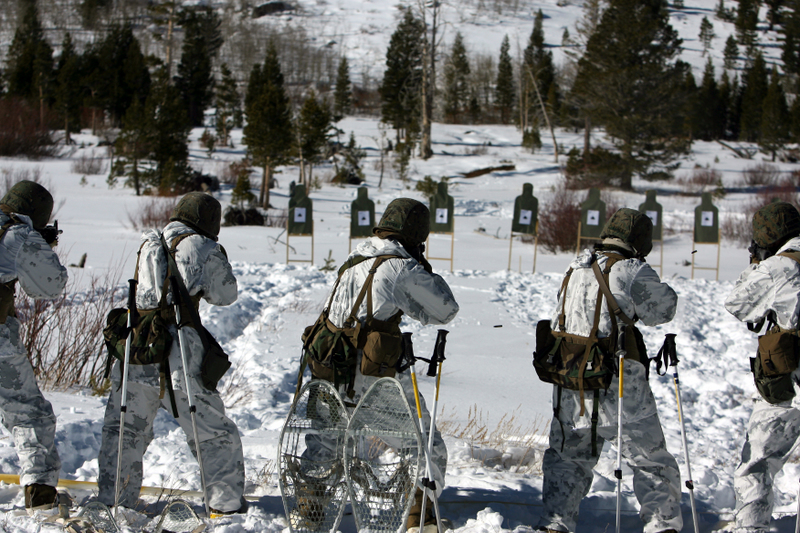MARPAT (short for MARine PATtern) is a pixelated camouflage pattern in use by the United States Marine Corps, introduced with the Marine Corps Combat Utility Uniform (MCCUU), which replaced the Camouflage Utility Uniform. The pattern is formed by a number of small rectangular pixels of color. In theory, it is a far more effective camouflage than standard uniform patterns because it mimics the dappled textures and rough boundaries found in natural settings. This is caused by how the human eye interacts with pixelated images. It is also known as the "digital pattern" or "digi-cammies" because of its micropattern (pixels) rather than the old macropattern (big blobs). The United States Marine Corps has patented MARPAT, including specifics of its manufacture[1], and registered the trademark "MARPAT"[citation needed]. By regulation, the pattern and items incorporating it, such as the MCCUU and ILBE backpack, are to be supplied by authorized manufacturers only and are not for general commercial sale, although imitations are available such as "Digital Woodland Camo" or "Digital Desert Camo".

Design and colors
MARPAT has patterns produced by highly complex fractal equations that result in a non-repeating pattern. The purpose of the digitized pattern is to match the visual texture of typical backgrounds. When compared to a white background the MARPAT does look surprising and would seem to catch attention, but when used in an operative environment, its textured appearance and lack of hard edges make it more effective than traditional patterns.[4]
There were initially three MARPAT patterns: Woodland, Desert, and Urban. Currently, only the Woodland and Desert patterns are used by the Marine Corps, replacing the U.S. Woodland pattern and the U.S. Three Color Desert pattern. The Urban pattern was not approved for use. A snow pattern has also emerged on cold weather training over-garments. [5]
Authentic MARPAT material is distinguishable by an Eagle, Globe, and Anchor emblem incorporated into the pattern, in both the Woodland and Desert patterns
Development
The concept of using miniature swatches of color as opposed to large splotches is not a new concept; in World War II, German troops used various patterns similar to the current German Flecktarn, which involved similar small dabs of color on a uniform to provide camouflage.
The USMC design team in charge of this process went through over 150 different camo patterns before selecting 3 samples that met their initial objectives. These were two versions of Tiger stripes and an older design of British DPM that used colors from Rhodesian. The influence of the Tiger stripes can still be seen in the final MARPAT. These 3 samples were then reconstructed using new shapes and unique color blends that would allow a more effective uniform in a great range of environments.
The new patterns were then field tested in different environments, day and night, with night vision and various optics. MARPAT did exceptionally well in their wet uniform test when viewed with night vision while illuminated with IR, where normally patterns appear as a solid.
The MARPAT patent lists U.S. Army research into fractal pattern camouflage as the basis for MARPAT.[2]
The MARPAT pattern was chosen in a run-off against seven other patterns at the USMC Scout Sniper Instructor School.[3]
MARPAT uniforms were issued in late 2003, but matching helmet covers were issued only later at the beginning of the Iraq war.

Design and colors
MARPAT has patterns produced by highly complex fractal equations that result in a non-repeating pattern. The purpose of the digitized pattern is to match the visual texture of typical backgrounds. When compared to a white background the MARPAT does look surprising and would seem to catch attention, but when used in an operative environment, its textured appearance and lack of hard edges make it more effective than traditional patterns.[4]
There were initially three MARPAT patterns: Woodland, Desert, and Urban. Currently, only the Woodland and Desert patterns are used by the Marine Corps, replacing the U.S. Woodland pattern and the U.S. Three Color Desert pattern. The Urban pattern was not approved for use. A snow pattern has also emerged on cold weather training over-garments. [5]
Authentic MARPAT material is distinguishable by an Eagle, Globe, and Anchor emblem incorporated into the pattern, in both the Woodland and Desert patterns.



